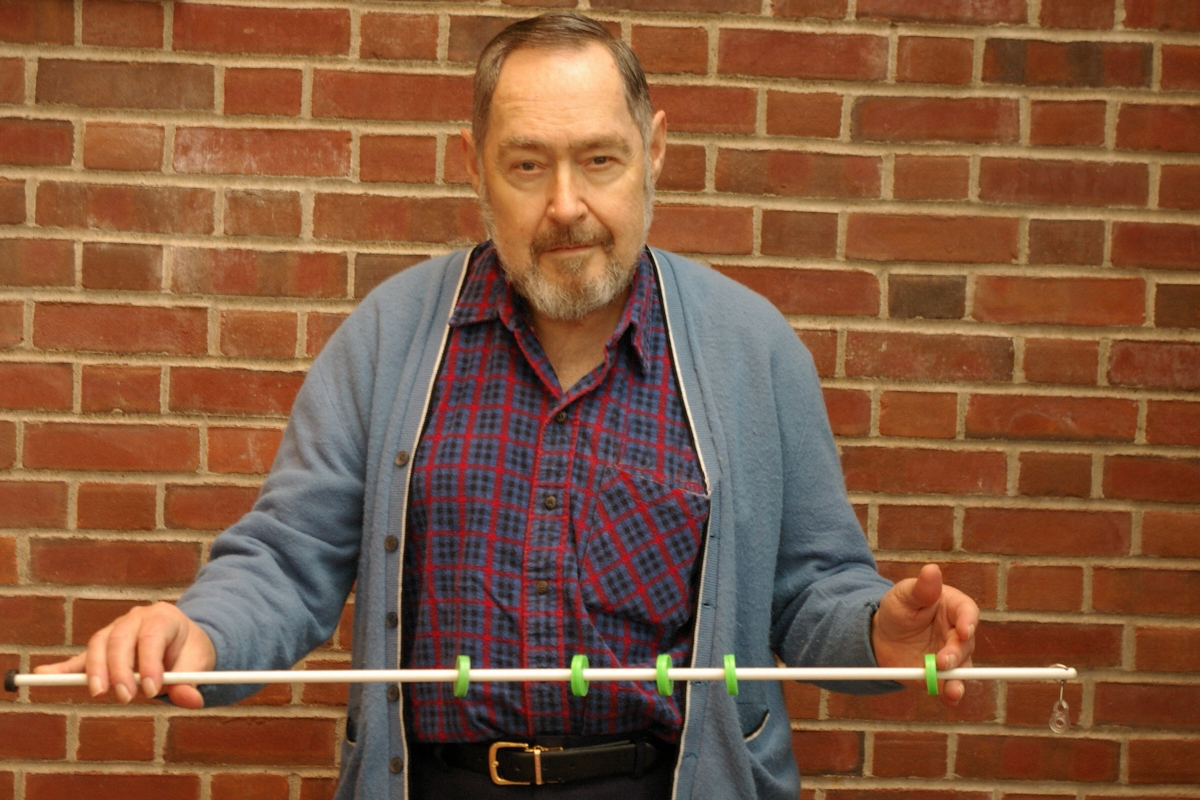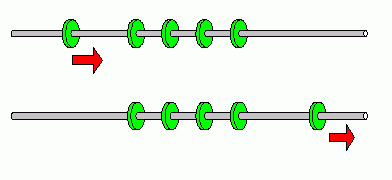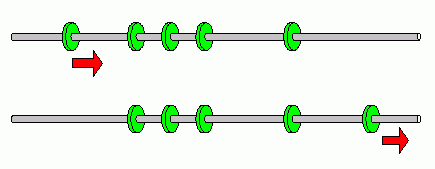Toys, Tricks and Teasers
by Donald Simanek.
THE PENETRATING MAGNETS ILLUSION.
Have you noticed toys marketed these days with names such as "Newton's Gizmo", "Newton's Cradle" "Newton's Gravity Glass", or something with Newton's name in it, when in fact, Newton never even saw some of these toys? Back in 2004 I invented a physics toy using magnets, one that I had not seen described elsewhere. So, I called it "Simanek's Penetrating Magnet Illusion". It obeys Newton's laws, like the others, but why should Newton get the credit? Hadn't he gotten enough credit already?This illusion toy is inexpensive and absurdly easy to build. Obtain a dozen or so of those small, flat ceramic magnets, 1-inch diameter, 1/4-inch thick with a 3/8-inch hole in the center. You can get them at Radio Shack, craft stores, hardware stores, etc. You don't need a whole dozen, but extras are good to have in case of breakage.
Thread five of these, with alternately opposing polarity, on a 1/4-inch diameter aluminum or plastic curtain rod, about 3 feet long. Such rod can be purchased in hardware stores. I put rubber washers (or corks) on the end of the rod, so the magnets won't slide off the ends. Don't use a steel or iron rod. Plastic rod is good, but it should be smooth and rigid. A wooden dowel is not as good, unless sanded very smooth, and, perhaps, varnished.
For a "magic trick" routine, you might begin this way. "Magnets are fascinating things, and they behave in unexpected ways. I will show you a little-known property of magnets, which actually allows them to penetrate through one another—under proper conditions, of course."
 |
| This version of the penetrating magnets illusion uses a plastic curtain-rod. The magnets are colored for visibility. |
|---|
Now hold the rod in a horizontal position. Spread out the magnets in the middle, so they are about equally spaced. Jiggle the rod so they find a position they "like". (Actually this spaces them so their magnetic repulsion is just about equal to the sliding friction.) Move the magnet at the left end away from the others, and then with two fingers behind it, propel it forcefully toward the others, so it hits with enough speed that you hear at least one collision. Before doing it, say you are going to make it "pass right through" the others without disturbing their position. Suggest to the spectators that they watch carefully the positions of the magnets. Now do it. Your claim seems to have actually happened, for one magnet seems to have gone all the way through, and the rest are in the same positions as initially. But in fact, the magnets end up in the positions that the stationary ones occupied before. The first two pictures in the figure show this.
 |
| The left magnet seems to pass right through the others. |
|---|
Now say, "Maybe you didn't see that, it happened so quickly." So reverse the action, by taking the one that seemingly passed through and propel it back toward the others. Same result: the others didn't seem to budge, but everyone heard noise as it "went through".
Someone will probably suspsect that the magnets just changed positions somehow. So this time start with the magnets in the center equally spaced except that you enlarge the spacing between two of them. Tell everyone to watch that larger spaced gap. Do it again, and after the magnet passes trough, the larger spaced gap is still there. The last two pictures in the figure show this.
 |
| Irregular spacing is preserved. |
|---|
Yes, you will occasionally crack a magnet, or knock a chip out of one, so have extras on hand. When this happens, just say "Sometimes, if the atoms aren't all perfectly aligned. They can't quite squeeze through the spaces between them, and one magnet is so stressed that it cracks." After discarding ones that chip or break, the remaining ones are probably the sturdiest ones. (Survival of the fittest?)
This demo is more fun than the Newton cradle, and a lot easier to keep in adjustment. You do need to encourage the audience to watch carefully whether the stationary ones change position. Tell them to listen to the sound as it collides. People are not normally observant of small details unless encouraged and told what to look for. A little practice will give you the "feel" for the best starting speed.
When I first played with this some years ago, I didn't discover this neat illusion (magic trick) because I was always being careful to avoid actual collisions of the magnets, thinking I might break them. So my caution prevented me using a larger speed and discovering how strong the illusion is when done properly and forcefully.
How it works. The magnets do exchange positions as they collide, but too quickly to observe. Put a small bit of colored tape on each one to verify this, if you doubt it. Each collision and exchange is completed without substantially disturbing the others, which is why we begin with the magnets separated enough that they don't influence each other much. In each collision conservation of momentum and energy ensure that the moving magnet stops and the previously stationary magnet achieves the same velocity as the one that collided with it. Then the next collision occurs, and so on down the line.
 |
| Colored magnets show what really happened. |
|---|
This also explains why a larger gap between magnets is preserved (wherever you make the gap and whichever direction the moving magnet goes). I have marked the initial position of magnets on the rod with a lead pencil, and find that the final positions of the magnets are often less than a millimeter different from the initial positions.
I haven't tried it yet, but I suspect that one could cover the magnet faces with felt and get results just as good, with less concern about breakage.
The similarity between this magnet demonstration and the classic toy "Newton's Cradle", sometimes called "the colliding balls", "the executive pacifier" and even "Newton's Balls" is striking. In this toy five suspended metal balls are initially barely touching. When one is pulled back and released, it collides, comes to rest, and one ball at the other end is propelled away at the same speed as the initially moving ball. If two balls are pulled back and released, then two balls at the other end are propelled away. It works for any number of balls, and this feature of the toy is the reason for its other name: "the counting balls". How does the system know how many balls to eject? Conservation of momentum and energy are responsible, as well as the fact that the balls have spherical shape, and equal mass and size. But that's a subject for a later column. I'll explain how you can make this toy inexpensively, for there are pitfalls to be avoided. Of course you could go out and buy one, but where's the fun in that?
 |
| Newton's Cradle. |
|---|
Just because the behavior of my "penetrating magnets" illusion is "something like" the classic Newton's Cradle doesn't mean the two are alike in all details. Newton's Cradle doesn't have friction. The balls do not exchange positions. The magnets do.